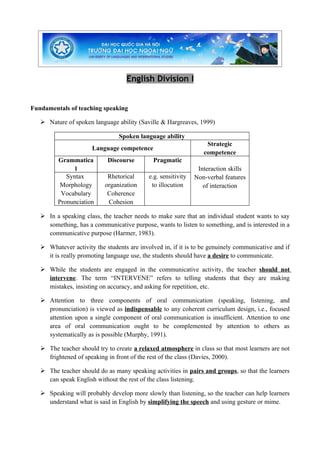
A Successful Speaking Lesson 2009
- 1. English Division I Fundamentals of teaching speaking Nature of spoken language ability (Saville & Hargreaves, 1999) Spoken language ability Strategic Language competence competence Grammatica Discourse Pragmatic l Interaction skills Syntax Rhetorical e.g. sensitivity Non-verbal features Morphology organization to illocution of interaction Vocabulary Coherence Pronunciation Cohesion In a speaking class, the teacher needs to make sure that an individual student wants to say something, has a communicative purpose, wants to listen to something, and is interested in a communicative purpose (Harmer, 1983). Whatever activity the students are involved in, if it is to be genuinely communicative and if it is really promoting language use, the students should have a desire to communicate. While the students are engaged in the communicative activity, the teacher should not intervene. The term “INTERVENE” refers to telling students that they are making mistakes, insisting on accuracy, and asking for repetition, etc. Attention to three components of oral communication (speaking, listening, and pronunciation) is viewed as indispensable to any coherent curriculum design, i.e., focused attention upon a single component of oral communication is insufficient. Attention to one area of oral communication ought to be complemented by attention to others as systematically as is possible (Murphy, 1991). The teacher should try to create a relaxed atmosphere in class so that most learners are not frightened of speaking in front of the rest of the class (Davies, 2000). The teacher should do as many speaking activities in pairs and groups, so that the learners can speak English without the rest of the class listening. Speaking will probably develop more slowly than listening, so the teacher can help learners understand what is said in English by simplifying the speech and using gesture or mime.
- 2. The teacher cannot so easily get learners to express themselves in English, but, when they do, the teacher should always show he/she is pleased even if what they say is far from perfect. There is a risk that, unless carefully handled, the act of correcting may impose an emotional burden on the learner. There is a need for speaking skills classes to place more emphasis on the FRAMES of oral interactions (how conversations are started, maintained and finished) to develop learners’ awareness of conversational features and strategies (McDonough & Shaw, 2003). Speaking is closely related to or interwoven with listening. As INTERACTION is the key to improving EFL learners’ speaking abilities, language instructors should provide learners with opportunities for meaningful communicative behavior about relevant topics. References Davies, P. (2000). Success in English teaching. Oxford: Oxford University Press. Harmer, J. (1983). The practice of English language teaching. London: Longman Group Limited. Johnson, K. & Morrow, K. (Eds.) (1987). Communication in the classroom: Applications and methods for a communicative approach. Longman Group Ltd. Lynch, T. (1996). Communication in the language classroom. New York: Oxford University Press. McDonough, J. & Shaw, C. (2003). (2nd ed.). Materials and methods in ELT: A teacher’s guide. Blackwell Publishing. Murphy, J. M. (1991). Oral communication in TESOL: Integrating speaking, listening, and pronunciation. TESOL Quarterly, 25(1), 51-75. Richard, J. C. (1990). The language teaching matrix. New York: Cambridge University Press. Richards, J. C. & Renandya, W. A. (Eds.). (2002). Methodology in language teaching: An anthology of current practice. New York: Cambridge University Press. Saville, N. & Hargreaves, P. (1999). Assessing speaking in the revised FCE. ELT Journal, 53(1), 42-51.
- 3. Speaking Lesson OBSERVATION SHEET Date: ……………………… Period: …. Room: ….. Mentor’s name: ……………………………………. Mentee’s name: ………………………………………… Classroom interactions How is student attention and interest maintained? To what extent does the lesson engage the learners? How is attention to instructional tasks maintained? Opportunities for speaking How much opportunity is provided for students to speak? What is the ratio of teacher talk to student talk? Quality of input How clearly are the goals of activities communicated to students? Is there a clear relationship between different activities within a lesson? To what extent does the teacher use translation or the native tongue in teaching? What kind of input is the teacher providing? How effectively are teaching aids employed? Grouping What grouping arrangements are employed? Are they effective? Is there a clear relationship between grouping patterns and instructional goals? Do students always work with the same patterns or in the same groups? Communicativeness To what extent is accuracy or fluency the focus of activities? Is there “negotiation of meaning” in the classroom? Are opportunities provided for real communication in the classroom? Are the tasks interesting and challenging to students? Questions What kinds of question patterns are used? Are questions distributed between teachers and students and among different students in the class? Feedback How appropriately does the teacher correct errors (grammar, pronunciation, intonation, choice of words) How does the teacher answer requests for clarification? How are communication breakdowns dealt with? How effective is the teacher’s feedback on task performance? Other comments